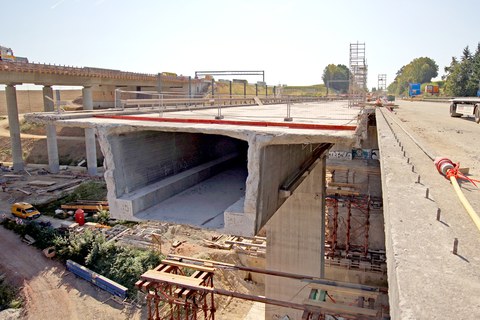Laboratory investigations on the deconstruction of the Lahntal viaduct
Table of contents
Project data
| Titel | Title Laboruntersuchungen zum Rückbau der Lahntalbrücke | Laboratory investigations on the deconstruction of the Lahntal viaduct Förderer | Funding DEGES (Deutsche Einheit Fernstraßenplanungs- und -bau GmbH) Zeitraum | Period 02/2018 – 12/2020 Leiter | Project manager Prof. Dr.-Ing. Steffen Marx Bearbeiter | Contributors Daniel Gebauer, M. Sc., Raúl Enríque Beltrán Gutierrez, M. Sc., Max Herbers, M. Sc. Projektpartner | Project partner Institut für Massivbau, Leibniz Universität Hannover |
Report from year book 2020
Lahntal viaduct – last steps

Deconstruction of the Lahntal viaduct
Within the framework of the endowed professorship for civil engineering (DB Netz AG), the research project “Laboratory Investigations on the Deconstruction of the Lahntal Viaduct” was relocated from Hanover to Dresden this year. The research project deals with the exciting topic of the evaluation of existing bridge structures, which has high relevance for infrastructure maintenance. What is the discrepancy between assumptions based on the original documents and actual material investigations? What does a suitable sampling concept look like? Which characteristic values should be determined?
The Lahntal Viaduct near Limburg (1962–2017), which was dismantled in 2016/17 because the load-bearing capacity could no longer be guaranteed due to a strong increase in traffic, served as the case-study structure. The deconstruction provided the opportunity to intensively sample the structure and to take a total of more than 260 cores and several test beams. Within the scope of the research project, the material parameters of the existing structure are determined on these samples. These include the compressive strength, the splitting tensile strength, the creep and fatigue behaviour of the concrete, the chloride penetration test, and the anchorage behaviour of the tendons as well as the condition of tendons and ducts. Accompanying non-destructive testing methods, such as rebound hammer testing and ultrasonic transit time measurements, were used and related to the destructive tests. The aim is to investigate and evaluate the existing structure to derive recommendations for the sampling of existing bridge structures in the future. The determined parameters are statistically evaluated and compared to the normative expected values.
While the investigations on compressive strength, split tensile strength and chloride stress have already been carried out at the Institute of Concrete Construction (IfMa) of Leibniz Universität Hannover, the anchorage, fatigue and creep behaviour are being worked on in cooperation with IfMa at the Institute of Concrete Structures (IMB) of the Technische Universität Dresden. The first results show significantly higher strengths compared to the normative expected values and the enormous potential of the experimental determination of material parameters of concrete bridges. These findings can help to save existing structures from demolition and to extend their service life. Besides, there are numerous new starting points for further investigations. Among other things, a round-robin test for non-destructive testing methods is planned.
